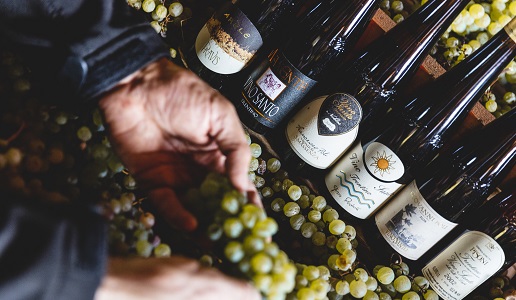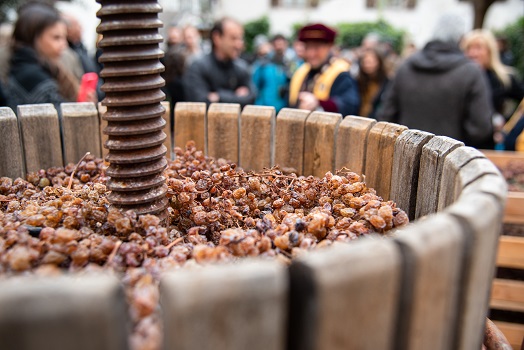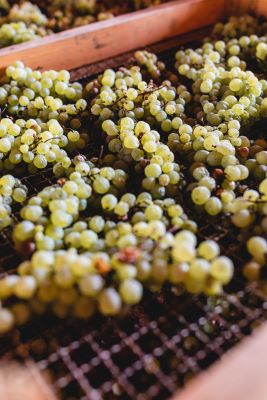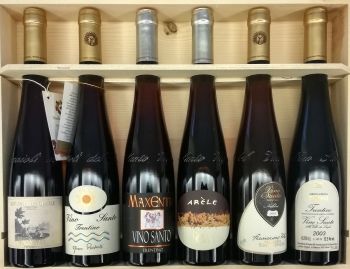Vino Santo Trentino, 100% terroir

In Trentino, in the Valle dei Laghi, from a handful of producers, an extraordinary wine originates. Son of a grape and child of the wind, Vino Santo Trentino
We do not hesitate to state it: there would be no Vino Santo without all the elements that make it up; it is 100 percent terroir. But what are these elements? Let us see them together.
1. Nosiola, native white grape variety constitutes the true white soul of Trentino
We could say that together with Schiava they were the undisputed rulers of the territory until 40-50 years ago. Today both are in danger of extinction; Nosiola boasts about 60 hectares, 40 of them in the Valle dei Laghi. Late-ripening, thick-skinned and waterproof, it is extremely versatile. An ancient grape variety but with modern twists. It loves to be rocked by the wind and can be made into wine fresh, especially from medium-young vines, giving fragrant, upright wines. Not particularly full-bodied, snappy in the glass, able to be appreciated from just a few months after harvest. However, when we talk about Nosiola from vineyards over fifteen years old, then the game gets interesting. Complex berries, restrained production, arrive at optimal ripeness to be then harvested and dried in the fruttaio. These will be the grapes (by specification a minimum of 85 percent) that will allow Vino Santo Trentino to be made.
2. Climate and territory
 The wind, I love this wind, I have "studied" it on my skin as often as I could. Actually we should talk about a combination of winds but the one that definitely dominates over all is the Ora del Garda. It starts blowing in the afternoon and you can feel it relentlessly every day doing its work. It originates south of Lake Garda and naturally channels itself into the shape of the lake itself. Narrow and with high walls on either side, this is the shape Garda takes to the north, in the province of Trentino. A perfect system that not only directs the wind but allows it to pick up speed. A coveted destination for sporting sailing enthusiasts from around the world, for Trentino winemakers Garda is the source of the Ora, the wind that mitigates, ensures healthiness of the grapes in the vineyards in the summer and guarantees the drying of the grapes in the fruttaio during autumn and winter.
The wind, I love this wind, I have "studied" it on my skin as often as I could. Actually we should talk about a combination of winds but the one that definitely dominates over all is the Ora del Garda. It starts blowing in the afternoon and you can feel it relentlessly every day doing its work. It originates south of Lake Garda and naturally channels itself into the shape of the lake itself. Narrow and with high walls on either side, this is the shape Garda takes to the north, in the province of Trentino. A perfect system that not only directs the wind but allows it to pick up speed. A coveted destination for sporting sailing enthusiasts from around the world, for Trentino winemakers Garda is the source of the Ora, the wind that mitigates, ensures healthiness of the grapes in the vineyards in the summer and guarantees the drying of the grapes in the fruttaio during autumn and winter.
The Valley of the Lakes is an area rich in water and light. The soils consist of dolomite, a white rock rich in minerals that sometimes emerges from the little organic matter in the subsoil. The whiteness of the rock and the various bodies of water present reflect sunlight, making the Valle dei Laghi a place of mountains but also of light. The Valley of the Lakes is a bright and wind-animated territory. Nosiola in particular loves the limestone marls near Lake Toblino; in fact, the vineyards are all concentrated there. The thin soils also help to naturally regulate its vigor, moreover favoring the formation of sparse clusters.
3. Technology and man

Over the years the technique has been refined and is still carried on today as it once was. I am talking about the drying process in fruit lofts, in small boxes and plateaus. The hand-harvested grapes are left to dry until Holy Week to be pressed in the piazza in an event open to the public charged with folklore and historicity. The nature of Nosiola itself and the windy microclimate of the Valle dei Laghi create the perfect conditions for the long, slow drying process. Over the course of months the berries can also be attacked more or less intensely and uniformly by noble rot, in its infavate form. This event gives additional depth and complexity to the Nosiola aromas that are punctually transferred to the wine. Seeing the berries change color in the course of drying is exciting and heralds great satisfaction in the cellar as well.
Vino Santo Trentino is for all intents and purposes a historical and cultural heritage that associations such as the Vignaioli del Vino Santo Trentino carry forward and defend year after year. Even when the market does not want to give it space or reason, after all, sweet wines are known to live a difficult period. To Vino Santo perhaps a real place on the table or "special occasion" is not even needed, it can be consumed even on its own thanks to its innate gift of not missing anything once we have it in the glass. 2022 data on Trentino viticulture attest 70% of Trentino grape production to Chardonnay, Pinot Grigio and Müller Thurgau. Nosiola weighs in at less than 6 percent across the region. Vino Santo comes in at about 15,000 bottles per year.
Liquid longevity and precious nectar fruit of hard work and alchemical skill. Mind you, Vino Santo...with an "o." Nothing to do with Vin Santo, an equally praiseworthy product but the child of another technique, to the point of being incomparable. Vino Santo is made from the must of dried grapes, fermentation is induced (high sugar concentrations and the presence of botrytis certainly do not facilitate alcoholic fermentation). Fermentation then stops while maintaining a natural residual sugar content in the wine itself. At this point the maturation phase begins, which can be done in wood and last more or less time.

From the tastings I have been able to make over the years, I have identified two main styles of Vino Santo. One style is more marked by oxidative characters, with an amber color and aromas more reminiscent of dried fruit and nuts. It is immediate and appealing from the earliest stages of its life, which is why it is often placed on the market among the earliest. And then a more taut style, which is conceded more slowly over time. The color is golden, the verticality innate, the aromas citrusy. It is unlikely to come out until ten years after the vintage, but the result is worth the wait. In both cases the longevity is astonishing, recently effortlessly passing the 40-year test...but in the past I have also tasted wines from the 1960s, and the astonishment is still vivid in my memories.
At DiVin Nosiola, I attended a tasting of fresh Nosiola and Vino Santo Trentino from the 2022 vintage, with Giovanni Poli's Nosiola. To Maxentia's Nosiola 2022, which makes 50 percent red wine from it. Then on to the Vini Santi: 2008 from Pravis, with a dense, oxidative style; 2003 from Gino Pedrotti, a wine I have also tasted on past occasions and that never ceases to give me new emotions. The 1998 by Francesco Poli, a winery whose 2006 I also point out, now on sale, an extraordinary vintage in which the noble rot did a splendid job. To finish with Pisoni's 1983, which is no longer a wine-it's liquid poetry that makes its way through balsamic notes of mountain herbs.
I love Nosiola and I love the Valle dei Laghi, and I will continue to drink Vino Santo without waiting for the famous special occasion that never comes. I invite you to do the same; you will see that the occasion ends up being the wine itself.
Related Products
| Product | Producer | Date of publication | Author | Read | |
|---|---|---|---|---|---|

|
Nosiola 2022
Vigneti delle Dolomiti |
Giovanni Poli | 06/02/23 | Sissi Baratella | |

|
Giovanni Poli
|
10/24/17 | Redazione | ||

|
Nosiola 2022
Vigneti delle Dolomiti |
Maxentia | 06/02/23 | Sissi Baratella | |

|
Maxentia
|
06/02/23 | Redazione | ||

|
Arele 2008
Vino Santo Trentino |
Pravis | 06/02/23 | Sissi Baratella | |

|
Pravis
|
06/02/23 | Redazione |
For these three winemaking friends, vines are life, experimentation and tradition. They have many small vineyards plots spread out in the suggestive Valle dei Laghi, kissed by the Ora del Garda wind... Leggi tutto |
|

|
Vino Santo Trentino 2003
Vino Santo Trentino |
Gino Pedrotti | 06/02/23 | Sissi Baratella | |

|
Gino Pedrotti
|
12/19/14 | Redazione |
The Pedrotti family estate is over 100 years old and operates in the southern part of the province of Trentino, in the beautiful Valle dei Laghi. The vineyards are being converted to biodynamic... Leggi tutto |
|

|
Vino Santo Trentino 2006
Vino Santo Trentino |
Francesco Poli | 06/02/23 | Sissi Baratella | |

|
Francesco Poli
|
06/02/23 | Redazione | ||

|
Vino Santo Trentino 1983
Vino Santo Trentino |
Pisoni dal 1852 | 06/02/23 | Sissi Baratella | |

|
Pisoni dal 1852
|
02/19/13 | Redazione |
It seams that since 17th century the Pisoni family gave its wines to Cristoforo Madruzzo, the Prince Archbishop Cardinal. Since then, the family has always made spirits and wines but it's the... Leggi tutto |

 Italiano
Italiano







